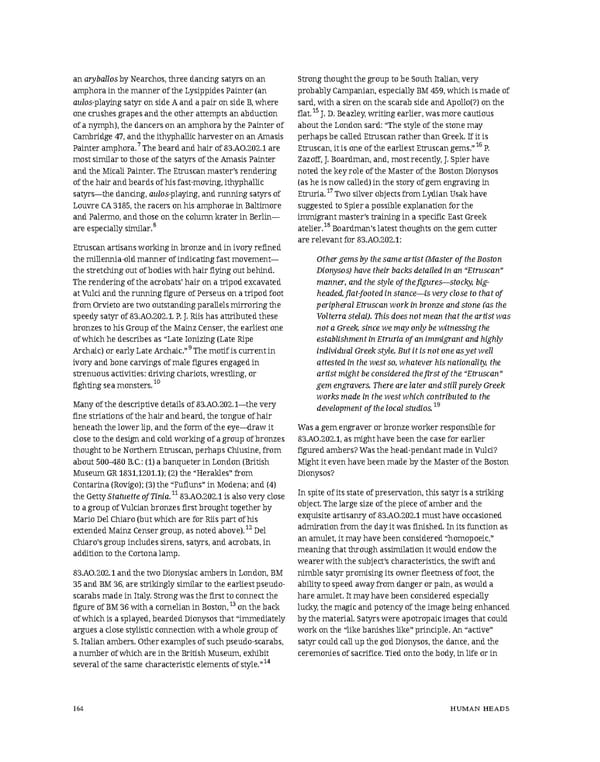anaryballosby Nearchos, three dancing satyrs on an Strong thought the group to be South Italian, very amphora in the manner of the Lysippides Painter (an probably Campanian, especially BM 459, which is made of aulos-playing satyr on side A and a pair on side B, where sard, with a siren on the scarab side and Apollo(?) on the one crushes grapes and the other attempts an abduction flat.15 J. D. Beazley, writing earlier, was more cautious of a nymph), the dancers on an amphora by the Painter of about the London sard: “The style of the stone may Cambridge 47, and the ithyphallic harvester on an Amasis perhaps be called Etruscan rather than Greek. If it is Painter amphora.7The beard and hair of 83.AO.202.1 are Etruscan, it is one of the earliest Etruscan gems.”16 P. most similar to those of the satyrs of the Amasis Painter Zazoff, J. Boardman, and, most recently, J. Spier have and the Micali Painter. The Etruscan master’s rendering noted the key role of the Master of the Boston Dionysos of the hair and beards of his fast-moving, ithyphallic (as he is now called) in the story of gem engraving in satyrs—the dancing, aulos-playing, and running satyrs of Etruria.17 Two silver objects from Lydian Usak have Louvre CA 3185, the racers on his amphorae in Baltimore suggested to Spier a possible explanation for the and Palermo, and those on the column krater in Berlin— immigrant master’s training in a specific East Greek are especially similar.8 atelier.18 Boardman’s latest thoughts on the gem cutter are relevant for 83.AO.202.1: Etruscan artisans working in bronze and in ivory refined the millennia-old manner of indicating fast movement— Other gems by the same artist (Master of the Boston the stretching out of bodies with hair flying out behind. Dionysos) have their backs detailed in an “Etruscan” The rendering of the acrobats’ hair on a tripod excavated manner, and the style of the figures—stocky, big- at Vulci and the running figure of Perseus on a tripod foot headed, flat-footed in stance—is very close to that of from Orvieto are two outstanding parallels mirroring the peripheral Etruscan work in bronze and stone (as the speedy satyr of 83.AO.202.1. P. J. Riis has attributed these Volterra stelai). This does not mean that the artist was bronzes to his Group of the Mainz Censer, the earliest one not a Greek, since we may only be witnessing the of which he describes as “Late Ionizing (Late Ripe establishment in Etruria of an immigrant and highly Archaic) or early Late Archaic.”9 The motif is current in individual Greek style. But it is not one as yet well ivory and bone carvings of male figures engaged in attested in the west so, whatever his nationality, the strenuous activities: driving chariots, wrestling, or artist might be considered the first of the “Etruscan” fighting sea monsters.10 gem engravers. There are later and still purely Greek works made in the west which contributed to the Many of the descriptive details of 83.AO.202.1—the very development of the local studios.19 fine striations of the hair and beard, the tongue of hair beneath the lower lip, and the form of the eye—draw it Was a gem engraver or bronze worker responsible for close to the design and cold working of a group of bronzes 83.AO.202.1, as might have been the case for earlier thought to be Northern Etruscan, perhaps Chiusine, from figured ambers? Was the head-pendant made in Vulci? about 500–480 B.C.: (1) a banqueter in London (British Might it even have been made by the Master of the Boston Museum GR 1831,1201.1); (2) the “Herakles” from Dionysos? Contarina (Rovigo); (3) the “Fufluns” in Modena; and (4) the Getty Statuette of Tinia.11 83.AO.202.1 is also very close In spite of its state of preservation, this satyr is a striking to a group of Vulcian bronzes first brought together by object. The large size of the piece of amber and the Mario Del Chiaro (but which are for Riis part of his exquisite artisanry of 83.AO.202.1 must have occasioned extended Mainz Censer group, as noted above).12 Del admiration from the day it was finished. In its function as Chiaro’s group includes sirens, satyrs, and acrobats, in an amulet, it may have been considered “homopoeic,” addition to the Cortona lamp. meaning that through assimilation it would endow the wearer with the subject’s characteristics, the swift and 83.AO.202.1 and the two Dionysiac ambers in London, BM nimble satyr promising its owner fleetness of foot, the 35 and BM 36, are strikingly similar to the earliest pseudo- ability to speed away from danger or pain, as would a scarabs made in Italy. Strong was the first to connect the hare amulet. It may have been considered especially figure of BM 36 with a cornelian in Boston,13 on the back lucky, the magic and potency of the image being enhanced of which is a splayed, bearded Dionysos that “immediately by the material. Satyrs were apotropaic images that could argues a close stylistic connection with a whole group of work on the “like banishes like” principle. An “active” S. Italian ambers. Other examples of such pseudo-scarabs, satyr could call up the god Dionysos, the dance, and the a number of which are in the British Museum, exhibit ceremonies of sacrifice. Tied onto the body, in life or in several of the same characteristic elements of style.”14 164 HUMAN HEADS
 Ancient Carved Ambers in the J. Paul Getty Museum Page 173 Page 175
Ancient Carved Ambers in the J. Paul Getty Museum Page 173 Page 175